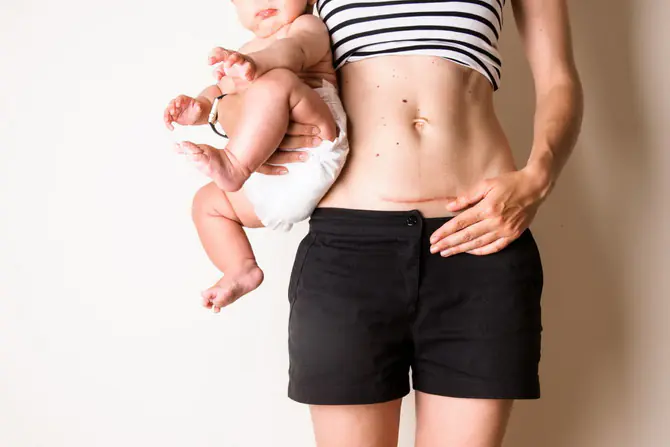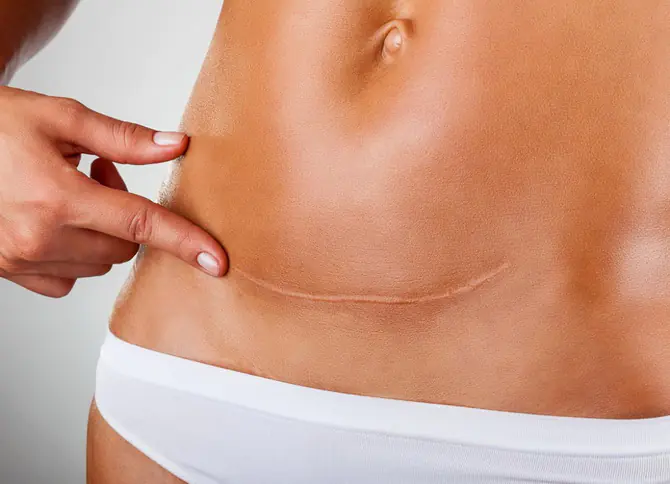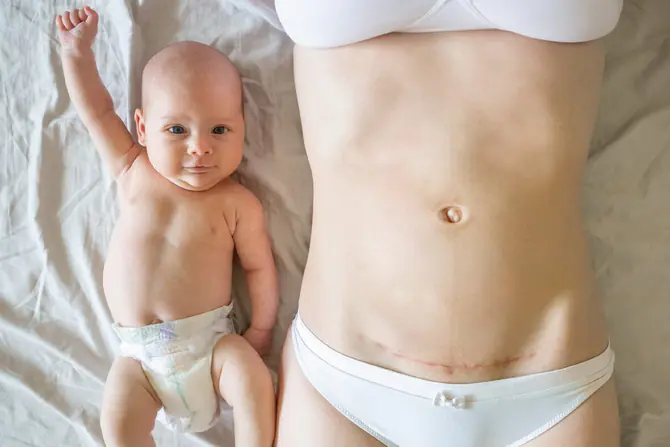Massage after a caesarean section plays a key role in speeding up the healing process and improving the appearance of the scar. However, it is extremely important to be patient and only proceed with these massages after receiving clearance from your healthcare provider.
Caesarean section involves a surgical method of delivery that leaves a noticeable scar on the mother's abdomen. In the United States, approximately one in three women choose a cesarean section. This article will serve as your guide to understanding the benefits of C-section scar massage and the proper techniques to perform it.
Is massage beneficial after a caesarean section?
Although it may not be possible to completely eliminate a C-section scar, you can greatly speed up the healing process and reduce complications by providing proper care. One effective approach is scar massage.

Post-cesarean massage is known for its ability to improve the aesthetics of scars. Gently massaging the C-section scar can smooth and soften it over time.
Additionally, massage is known to relieve pain, itching, and hyperpigmentation at the incision site. They also help loosen scar tissue and increase skin firmness and elasticity. This can play an important role in preventing the development of a “bully belly” after a C-section, where excess flesh hangs over the scar. In addition, scar massage improves blood circulation in the area, promoting collagen formation and speeding up scar healing.
Types of Scars
Typically, C-section scars are approximately 10 to 15 centimeters long. They initially appear pink and swollen, gradually flattening over time. There are two main types of C-section scars:
- Transverse scar from caesarean section: this is the more common variety, running horizontally along the lower abdomen, usually in line with the line of the underwear.
- Vertical scar from caesarean section: This type is usually used in emergency surgeries because it allows the baby to be removed quickly. A vertical scar usually runs from the navel to the pubic line.
Notably, vertical scars carry a higher risk of complications and wound healing problems compared to transverse cesarean section scars.
How to massage scars after a caesarean section
The Caesarean section procedure involves cutting seven layers of tissue, including the skin, connective tissue, abdominal muscles and uterus. Effective C-section scar massage must systematically target each of these layers to achieve optimal results.
Cesarean section scar massage involves three key steps:
- Superficial layers of skin and fat
- Muscles and connective tissues
- Deep tissue

Layer 1: Superficial layers of skin
In the first weeks after surgery, you can focus on the superficial layers of skin and fat. As scar tissue becomes less sensitive over time, you can gradually apply deeper pressure.
- To begin, use your fingertips to gently explore the texture of the skin just above the scar line.
- Move the skin in different directions—up and down, side to side, and in circular motions—to assess the firmness and tenderness of the tissue.
- Notice if certain directions cause more resistance; if so, concentrate on gently massaging in these directions to stretch and loosen the scar tissue.
- During the first three to six weeks of healing, the scar line may remain tender. Concentrate on massaging the skin both above and below the scar line. As the tissue becomes less sensitive, you can gradually massage the scar line itself.
- When ready, gently pinch the scar, lifting the skin, and roll the scar line with your fingertips. Alternatively, move the scar and surrounding skin in different directions to increase tissue mobility.
While some discomfort is normal during a massage, it should never be painful.
Layer 2: Muscles
Beneath the superficial layers of skin and fat are the abdominal muscles and connective tissues. To correct these problems, you will need to apply more pressure to your abdomen—above, below, and on top of your scar.
- To massage the muscle layer, use your fingertips to press on the skin around the scar, looking for the abdominal muscles underneath.
- Move your fingers up and down, side to side and in small circles, maintaining an appropriate level of pressure.
- If any part of the scar feels tight, gently stretch the skin and muscles until it reaches a comfortable limit. Hold your fingers in this position until the fabric softens.
- Be careful not to apply excessive force to the muscle tissue, as this may damage the healing fibers. If pain allows, pinch the scar line as deeply as the muscle layer allows and roll the tissue between your fingertips.
Layer 3: Deep tissue
Once you feel ready, you can begin massaging the deepest layers of your abdomen. This level of pressure should resemble the firmness of a healthcare professional testing for appendicitis or kidney problems.
- To target deep tissue, lie on your back with a pillow under your knees to ensure complete relaxation of the abdominal tissues.
- Press the pads of your fingers into your abdomen as deeply as comfort allows.
- Similar to the previous layers, use massaging movements—up and down, side to side, and in circular motions—both above and below the scar.
- If any area feels tight, gently stretch the tissues and maintain the stretch until the tissues soften.
- If your scar line is ready, continue rolling it between your fingers, penetrating as deep as the layers of abdominal tissue will allow.
- Dense scar tissue in this area can impede blood flow to the bladder, potentially leading to bladder injury and urinary complications in some women. To minimize the formation of excess scar tissue, massage the entire area between the scar and the pelvic bone.
Try to spend ten minutes twice a day massaging your C-section scars for at least six weeks. After this, reduce the frequency to three to four times a week until the color of the scar fades and it becomes even.
When to start massaging scars after cesarean section
Before beginning massage after a cesarean section, consult your healthcare provider. Most health care providers recommend waiting three weeks after surgery before getting regular massage. Make sure the scab on your scar has healed before you begin the massage.
Stages of healing of cesarean section scars
The healing process of a scar after a cesarean section occurs in three main stages:
- Inflammatory stage, lasting three to five days after surgery, is characterized by stopping bleeding and the appearance of pink swelling. During this phase, platelets and white blood cells combine at the incision site to stop bleeding and prevent infection.
- Proliferation stage, lasting approximately five to 15 days, indicates collagen formation at the incision site. Collagen plays a key role in connecting the edges of damaged skin along the incision. New blood vessels also appear during this phase, making the scar thicker.
- Remodeling stage, the final stage of the healing process, can last up to a year. At this stage, the scar gradually aligns with the skin and changes color.
When to avoid massage
It is extremely important to consult with your healthcare provider before beginning daily scar massage. Avoid massage after a caesarean section if:
- The scar is less than three weeks old.
- A scar is an open cut or wound.
- Signs of infection, such as increasing pain, redness, or pus, appear around the scar.
- The scar is a complication.
- The age of the scar exceeds 18 months, since massage at this stage is unlikely to provide significant benefit.

Is it too late to start scar massage for my C-section scar?
A cesarean section scar is considered fully matured after 12-18 months. After this point, the benefits of scar massage diminish. If a year has passed and you are still unhappy with the texture or appearance of your scar, you may want to explore alternative options such as laser therapy or surgical scar revision.
Additional care measures
In addition to massaging C-section scars, several additional techniques can help with the healing process:
- Daily Walking: Incorporate daily walks into your daily routine to improve circulation, reduce the risk of blood clots, and relieve constipation.
- Regular moisturizing: Consult your healthcare professional to determine the best moisturizer for your needs. They may recommend Vaseline or antibiotic ointment once the wound is closed.
- Frequent dressing changes: Change your surgical dressing at least once a day or whenever it becomes wet or dirty.
- Silicone therapy: Talk to your healthcare provider about silicone gels and sheets that help keep the incision site moist, reduce itching, protect against infection, and promote smoother, smoother scar healing.
- Prevention of infection: Clean the incision site at least once a day and whenever you change the dressing. Gently clean the scar with mild antibacterial soap and water, avoiding vigorous scrubbing.
- Sun protection: Protect your scar from direct sunlight, as scars are especially sensitive to UV damage during the first 18 months after surgery. Keep the scar covered when outdoors.
- Avoid heavy lifting: While your scar is healing, refrain from lifting anything heavier than your baby. Also, hold off on strenuous exercise until your healthcare provider gives the OK.
- Refrain from intimacy: wait until your doctor gives the okay before resuming sexual activity.
- Avoid soaking: While showering is fine, avoid soaking in pools or hot tubs until cleared by your doctor.
- Tampons and douching: Wait until your six-week postpartum checkup to reuse tampons or douches. Always get your doctor's approval in advance.
Prevention of infection
If you suspect your C-section scar has become infected, contact your healthcare provider immediately. Signs of infection at the incision site include increasing pain, redness, swelling, pus, foul-smelling drainage, and fever.
How to make your own massage oil? We have the best recipes.
Read about kneading - the main technique in massage - in this article.
FAQ
How soon after a caesarean section can I start scar massage?
You can usually begin scar massage once the incision has completely healed, usually about 2-4 weeks after surgery. However, consult your doctor for individual recommendations.
Are there any risks associated with massaging C-section scars?
Massaging C-section scars is generally safe as long as it is done gently. However, if you experience increased pain, redness, or other unusual symptoms, consult your healthcare provider.
Can massage completely remove C-section scars?
Although scar massage can improve the appearance of C-section scars, it cannot completely eliminate them. The degree of improvement varies from person to person.
Are there specific massage techniques for different types of C-section scars?
Yes, massage techniques may vary depending on the type and location of your C-section scar. It is advisable to consult with your physician or occupational therapist for individualized guidance.
Can I use any lotion or oil to massage my scars?
It is best to use a gentle, hypoallergenic lotion or oil to avoid possible skin irritation. Consult your healthcare professional if you have any doubts about the products you may use.
Can scar massage help with C-section pain?
Yes, scar massage can help relieve the pain associated with a C-section by reducing adhesions and improving circulation to the scar tissue.
C-section scar massage provides valuable assistance in speeding up healing and improving the visual and tactile sensation of your scar. To begin regular massage, consult with your healthcare provider once your incision has healed and you've passed the three-week post-surgery threshold.
Keep your scar moisturized and apply gentle massages along the contour of the scar. Additionally, massaging the surrounding skin is helpful in the healing process.



